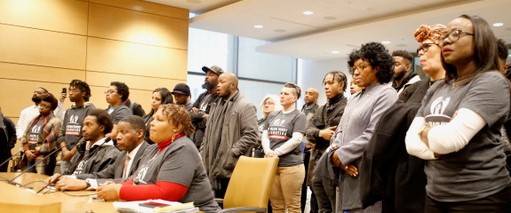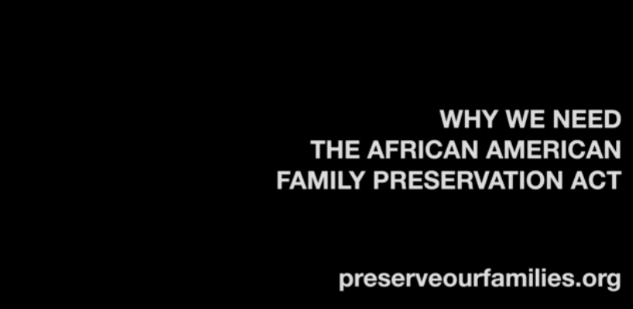Q&A with Kelis Houston
By Keyna Franklin, Rise Parent Leader, and Robbyne Wiley, Rise Parent Leader

Last year, Rise interviewed Kelis Houston, a family advocate and child welfare policy consultant in Minnesota, about Minnesota parents and allies fighting to address racial bias and violations of parents’ rights by the child welfare system. Rise spoke to Kelis again to get an update on the African American Family Preservation Act.
Q. What made you get into this work?
A: I worked at (what was at that time) Hennepin County Central Intake Shelter, the first stop for kids removed from their families. I witnessed the trauma that kids experience when separated and the trend of racial disproportionality. At any given time, 100% of the kids on my unit, which was the emergency shelter unit, were African-American kids and when they were there, they were with us for much longer periods of time than their Caucasian peers. A lot of them came back three or four times before aging out without permanency. I then worked as a Cultural Specialist Guardian Ad Litem, thinking it was something that could be addressed in the courts. I wanted to have a voice there. That’s when I saw how the county and courts perpetuated disparities. That led me to the capital to talk about what I was seeing and get legislative help in addressing the issue.
Q. How do racial disparities we see in the child welfare system today connect to the history of family separation in this country?
A: African-Americans only make up about 7% of Minnesota’s population, but in our two largest and most diverse counties, 50%-60% of the kids in care are African-American. Our kids are the highest population moving from child protection to juvenile detention. Our parents, even though we are coming in with lesser allegations, are the highest population having termination of parental rights. At every point of contact with the system, racial disparities exist for our families. The child welfare system’s knee jerk reaction to anything they are uncomfortable with or just don’t understand in our community is to take our kids and place them in white foster homes, even when there are relatives available who are willing to care for them.
It’s very similar to the slave trade. We know that historically we have never had authority and ownership over our bodies and the bodies of our children. Unfortunately, child protection uses the police and legislation to continue that practice. We have parents coming into the system for issues unrelated to their child’s safety. Because of the color of their skin, they are having their kids removed. Because they don’t have resources to get counsel outside of what the county provides, they are losing their children to the state. This has been going on since we were kidnapped and brought here. Plantation owners would take the kids and sell them off as property, and that’s similar to what’s happening now because of IV-E federal funding. We have over 15,000 kids in care in the state of Minnesota. It’s almost like a transfer of wealth. We are taking kids from urban areas and placing them in suburbs and rural counties. We are then paying those families an exorbitant amount to care for our kids, when it would take a fraction of that to just deal with whatever “crisis” was going on in the home. When you have a cultural lens and a poverty lens, it’s not a crisis at all. Right now we are spending $28,000 a year per child to place children in foster care, and typically, the family just needs housing and resources. It’s about $5,000 per year for in-home service provision.
African-American families are not coming into child protection because they are abusing their kids. The primary reason for involvement is neglect. Here, neglect could mean anything: inadequate food, clothing, or shelter. I call it a “catch all” statute. Because of this vague, broad statute, we are seeing social workers creating narratives to support whatever their position is on the family.
We talk about institutional racism as if it is this big mystical problem that appeared out of nowhere, like we don’t know how to fix it. Everyday decisions perpetuate policies that keep institutionalized racism in place. We have new workers coming from rural counties. We have workers who have no contact with the African-American community, no cultural context to refer to, and we are asking them to go in and assess homes. Of course bias is going to play a role. They don’t know what they are seeing and hearing. They don’t know our cultural norms, beliefs, values, and parenting styles.
I’ve seen parents dinged because they didn’t make baby sounds to their baby. The cultural piece is huge. They are going into urban areas that have been deemed “at risk” and are using risk assessments as a means to take children. Everybody is at risk if you look at it the way we do here. We have to separate risk from true danger so we can stop systemically targeting communities that have no control over the creation of these environments.
Q. What is the goal of the African American Family Preservation Act?
A: The overarching goal of the African American Family Preservation Act is to stop the arbitrary removal of black children from their homes by child protection. In Minnesota, we have provisions in law that should protect our families and our children from being wrongfully removed, but when the family is African-American, the law is widely ignored. We need a standard in place so that we can hold counties and the state accountable.
The first major part of the bill requires that a county provide an in-home safety plan, engaging family and community support around the family before they can remove a child. It requires the county to make active efforts, as opposed to reasonable efforts, to preserve the family.
If an out-of-home placement is absolutely necessary, it would mandate that they make active efforts to place children with the non-adjudicated or non-custodial parent.
It would stop the courts’ ability to terminate parental rights based solely on a parent’s inability to complete all of their case plan requirements.
It would expand our current appeal time for termination of parental rights (TPR). Right now, if you go through a TPR, you get 20 days to appeal that decision. The bill would expand that to 120 days.
It would also create an African-American Child Welfare Oversight Council appointed by the commissioner, and an African-American Child Well-Being Department within DHS. Those two entities would provide oversight to county agencies working with African-American families, similar to the role that tribes play for Native American families. It would supply grants to African-American-led organizations to provide services to our families, and to help with implementation of the bill.
We have work to do to restructure what we call services here. We categorize things like parenting assessments, mental health evaluations, drug tests, and Rule 25 as “services” — things that don’t get at the actual needs of the family.
The bill is going to help because we are lifting and defining family preservation services. Those services would be defined by the family, not child protection. We don’t all need mental health services. If we do, we don’t need it to be from white providers. Families should be able to choose who they get services from. Plans could include things like housing assistance, transportation, employment training, child care and food support, to get at some of the concrete basic needs of families. Not every plan is going to require those things, but when they do, we want the freedom to address it.
Q. What is the status of the bill?
A: The bill moved through the House with all “yes” votes last session, but DHS was allowed to create a fiscal note in the end that ultimately killed the bill. They added a $36 million fiscal note that had nothing to do with the content of the bill. That was ultimately why it wasn’t added to the omnibus bill.
We are back this session. I have been meeting with several counties and DHS to go over the language of the bill. We are working to come to a compromise to try to meet the March 20th deadline so that we can start getting the hearings we need in the Senate for this current session. The good thing is, we are working with the counties and DHS this session. Last year, it was just with the community. We have only two African-American commissioners here, in Hennepin County and Ramsey County. They are both in support of this bill, which says a lot. They helped us last session. Now we have a larger group behind it.
Q. How are parents in Minnesota organizing for change and advocating for the Act?
A: Parents showed up last legislative session during committee hearings to share their stories. Parents showed up to the legislative task force on child protection, created by the Governor after Eric Dean’s death in 2014. They are contacting their senators and representatives in support. Parents aren’t often heard in this process, so it is important that we always keep them at the forefront. Often legislative hearings are scheduled during the weekday, which can make it difficult for parents to attend, but parents are showing up because this is so important. Parents participated in creating a video that is part of a recent media campaign. We are also using social media to raise awareness.
Q. How can people across the country learn more and support parents in Minnesota who are advocating for change?
A: You can go to preserveourfamilies.org to learn more and sign up to get updates. It would be great if folks would take the bill and replicate the language to make similar pushes in other states, because this is a nationwide issue. The goal is to eventually have a federal family preservation act.
Additionally, we need attorneys that are willing to donate time and listen to cases of parents who may have a civil suit or lawsuit based on their experience with child protection. There is so much injustice happening and so many children and families being harmed.
Q. What actions can parents take if CPS gets involved in their lives?
A: Contact an attorney and find an advocate immediately. Reach out to your county commissioner, state rep, and senator for help. Contact the DHS commissioner and county decision makers. Go over the heads of your social worker and their supervisor. Make as much noise as possible. Know what the law says so that you can fight. I always tell parents to refer to the child protection law and speak up for themselves when they get to court. The judge only knows what is presented to him, typically just by the county and the county attorney. When the child welfare agency is doing something against the law–if they didn’t allow due process, if they didn’t create a safety plan before they removed your kids–I encourage parents to bring those things up in court. It’s important that they are on record.

